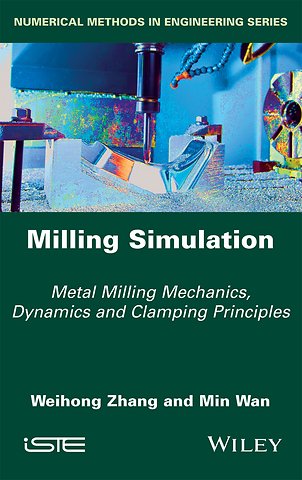Milling Simulation – Metal Milling Mechanics, Dynamics and Clamping Principles
Metal Milling Mechanics, Dynamics and Clamping Principles
Specificaties
Inhoudsopgave
<p>Introduction xi</p>
<p>Chapter 1. Cutting Forces in Milling Processes 1</p>
<p>1.1. Formulations of cutting forces 1</p>
<p>1.1.1. Mechanics of orthogonal cutting 1</p>
<p>1.1.2. Cutting force model for a general milling cutter 4</p>
<p>1.2. Milling process geometry 8</p>
<p>1.2.1. Calculations of uncut chip thickness 8</p>
<p>1.2.2. Determination of entry and exit angles 12</p>
<p>1.3. Identification of the cutting force coefficients 24</p>
<p>1.3.1. Calibration method for general end mills 24</p>
<p>1.3.2. Calibration method in the frequency domain 33</p>
<p>1.3.3. Calibration method involving four cutter runout parameters 39</p>
<p>1.3.4. Identification of shear stress, shear angle and friction angle using milling tests 48</p>
<p>1.4. Ternary cutting force model including bottom edge cutting effect 55</p>
<p>1.4.1. Calculations of FB( ) 57</p>
<p>1.4.2. Calculations of FB( ) 57</p>
<p>1.4.3. Calibration of Kqc (q = T,R) 58</p>
<p>1.4.4. Calibrations of Kq,B (q = T,R) 59</p>
<p>1.4.5. Experimental work 61</p>
<p>1.5. Cutting force prediction in peripheral milling of a curved surface 61</p>
<p>1.5.1. Calculations of instantaneous uncut chip thickness 65</p>
<p>1.5.2. Calculations of entry and exit angles 67</p>
<p>Chapter 2. Surface Accuracy in Milling Processes 71</p>
<p>2.1. Predictions of surface form errors 71</p>
<p>2.1.1. Calculation of cutting forces and process geometries 73</p>
<p>2.1.2. Iterative algorithms of surface form errors 81</p>
<p>2.2. Control strategy of surface form error 89</p>
<p>2.2.1. Development of control strategy 89</p>
<p>2.2.2. Verification of control strategy 93</p>
<p>2.3. Surface topography in milling processes 95</p>
<p>2.3.1. Prediction method for flat–end milling 97</p>
<p>2.3.2. Prediction method for multi–axis ball end milling 101</p>
<p>Chapter 3. Dynamics of Milling Processes 115</p>
<p>3.1. Governing equation of the milling process 115</p>
<p>3.2. Method for obtaining the frequency response function 120</p>
<p>3.2.1. Derivation of calculation formulations 121</p>
<p>3.2.2. Identification of model parameters 134</p>
<p>3.3. Prediction of stability lobe 139</p>
<p>3.3.1. Improved semi–discretization method 139</p>
<p>3.3.2. Lowest envelope method 144</p>
<p>3.3.3. Time–domain simulation method 155</p>
<p>Chapter 4. Mathematical Modeling of the Workpiece–Fixture System 165</p>
<p>4.1. Criteria of locating scheme correctness 165</p>
<p>4.1.1. The DOFs constraining principle 165</p>
<p>4.1.2. The locating scheme 168</p>
<p>4.1.3. Judgment criteria of locating scheme correctness 172</p>
<p>4.1.4. Analysis of locating scheme incorrectness 173</p>
<p>4.2. Analysis of locating scheme correctness 175</p>
<p>4.2.1. Localization source errors 175</p>
<p>4.2.2. Fixture modeling 176</p>
<p>4.2.3. Locating scheme correctness 182</p>
<p>4.3. Analysis of workpiece stability 186</p>
<p>4.3.1. Modeling of workpiece stability 186</p>
<p>4.3.2. Solution techniques to the model of workpiece stability 194</p>
<p>4.4. Modeling of the workpiece–fixture geometric default and compliance 201</p>
<p>4.4.1. Source error analysis 201</p>
<p>4.4.2. Workpiece position error 207</p>
<p>4.4.3. Machining error analysis 212</p>
<p>4.5. Optimal design of the fixture clamping sequence 218</p>
<p>4.5.1. Effect of clamping sequence on high–stiffness workpiece 218</p>
<p>4.5.2. Effect of clamping sequence on low–stiffness workpiece 224</p>
<p>4.5.3. Optimization of clamping sequence 225</p>
<p>Bibliography 229</p>
<p>Index 245</p>

